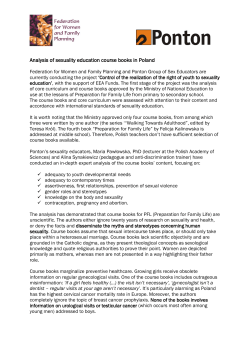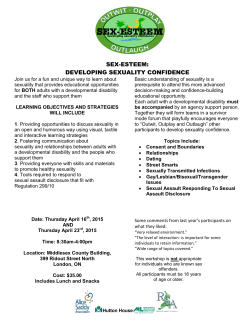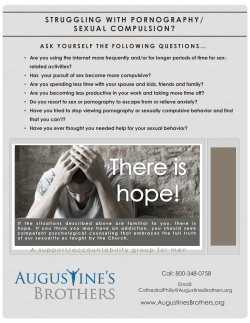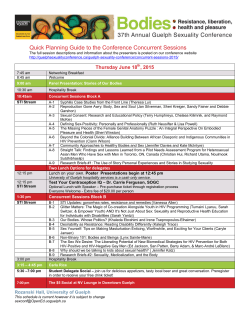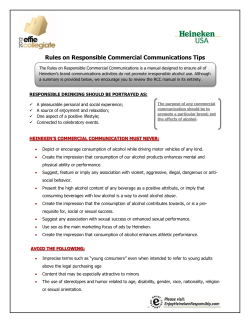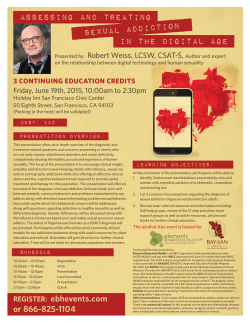
Carson 2015 Review - Teen Sex by the Book
A critical analysis of Teen Sex by the Book by Deanne Carson Deanne Carson 2015 1 ABOUT THE AUTHOR Deanne Carson is a sexuality education professional working in Melbourne, Victoria. Deanne's research in gender, sex and sexuality has shown that providing sexuality education that is inclusive of all young people, teaches affirmative consent and respects the values of individual students is essential in promoting positive outcomes for teens. Deanne has also researched the ways in which young people use digital technology to explore and express sexuality and will be speaking on this topic in April 2015 at the Sexual Cultures 2 conference in London. deannecarson.com info@deannecarson.com Deanne Carson 2015 2 CONTENTS Summary Part One: Program Content • promotes negative gender stereotypes about sexual desire and responsibility • promotes 'purity culture', where the only acceptable expression of sexuality is within a Christian marriage • teaches that sex, gender and sexuality diverse people exist due to the sins of the world and introduces false information about the 'success' of 'reparative' (conversion) therapy for LGBTIQ+ youth. • overstates, and presents as fact, the dangers - both emotional and physical of sex outside of marriage • reinforces messages that lead to 'victim blaming' of sexual assault survivors • speaks of divorce being a 'sin' and is dismissive of domestic violence issues • anti-abortion messages instead of neutral information Part two: Proselytising Tactics • sidelines parents as the adults with whom students are encouraged to speak • references reputable sources and information alongside religious dogma to give the latter credence • presents factual information that students would have learned in years 5 - 7, to lend authority to the curriculum in its entirety • • indulges in 'guilt by association' logical fallacy uses case studies almost exclusively told from the girls' perspective to reinforce the message of girls as the gatekeepers to purity. Conclusion Appendix Deanne Carson 2015 3 Summary Teen Sex by the Book (TSBTB) is a sexual health curriculum 'intended for upper high school students (aged 15+) and is written from a Christian perspective.'1 It is currently being delivered in NSW state secondary schools by SRE providers. While 'it is not intended to replace sex education',2 it is undeniably being delivered as sex education. Unlike sexual health education delivered by schools and independent external providers, it is only 'includes some scientific information but is not entirely scientific in nature'.3 This analysis will argue that the content being delivered is, at best, contradictory to the current NSW sexual health curriculum and best practices in teaching sexual health. At worst, it is discriminatory and contains content known to increase negative physical and mental health outcomes for some groups in our society. TSBTB is published by Christian Education Publishing (CEP) for use in Australian secondary schools. It comprises: • • • • Teen Sex by the Book, Patricia Weerakoon Teen Sex by the Book: teacher's manual, Belinda Elliot Teen Sex by the Book: student handbook, Belinda Elliot Teen Sex by the Book - DVD to accompany the teacher's manual The material: • promotes negative gender stereotypes about sexual desire and responsibility • promotes 'purity culture', where the only acceptable expression of sexuality is within a Christian marriage • teaches that sex, gender and sexuality diverse people exist due to the sins of the world and introduces false information about the 'success' of 'reparative' (conversion) therapy for LGBTIQ+ youth • overstates, and presents as fact, the dangers - both emotional and physical - of sex outside of marriage • reinforces messages that lead to 'victim blaming' of sexual assault survivors • speaks of divorce being a 'sin' and is dismissive of domestic violence issues • oblique anti abortion messages instead of neutral information. The authors use a variety of tactics to encourage students to 'commit to following God's way of living sexually and recreationally' including: • • • • sidelining parents as the adults with whom students are encouraged to speak encouraging students to judge parental values if their parents are not living a Christian life using reputable sources and information alongside religious dogma to give the latter credence presenting factual information that students would have learned in years 5 - 7 to lend authority to the curriculum in its entirety 1 Elliott, Belinda Teen Sex by the Book: teacher's manual p 7 2 ibid 3 ibid Deanne Carson 2015 4 • Indulges in 'guilt by association' logical fallacy. • Uses case studies almost exclusively told from the girls' perspective to reinforce the message of girls as the gatekeepers to purity. The teacher's manual gives tips on creating a safe space: • 'confidentiality - what is said in the class stays in the class • right to pass - students may choose not to contribute, but the teacher and the class should understand that everyone has something to offer • no name-calling, judgement or accusations • agree to disagree on opinions • don't generalise - use "some" not all • speak from your own point of view - use "I" not "they".'4 These guidelines do not include any instructions on discriminatory speech on the basis of age, gender, sexuality, religion, race, socio-economic background or ability. While the guidelines offer students the 'right to pass', on several later occasions the teacher's manual encourages teachers to pressure student participation. '... tell the class when the formal discussion will be taking place and that all students will be expected to contribute.' 5 4 ibid p 9 5 ibid p 21 Deanne Carson 2015 5 Part One: Program Content Promotes negative gender stereotypes about sexual desire and responsibility Gender differences clearly emerge from this research and indicate that an approach which places health information in the broader context of the social interactions between young people and which assists them to appreciate and deconstruct the limitations of gender expectations and stereotypes is necessary. - Teaching Sexual Health, NSW Department of Education and Communities Teen Sex by the Book, p 120 Throughout the texts, the message is repeatedly given and reinforced that males and females are different. '"He, [God] created them as male and female.'"So they were perfectly gendered as male and female. We can assume that Adam would have had a perfect body with just the right amount Deanne Carson 2015 6 of contoured muscles and wonderfully structured and functioning genitals. Eve would have had the perfect hourglass figure.'6 They have different bodies, different roles to play and different responses and responsibilities in regards to sex. The desirability of a ‘perfect’ body is proposed. It is reinforced that girls have a greater role to play in acting as sexual 'gatekeepers', that they are able to manage their sexual desire whereas for boys it is a biological urge almost beyond their control. 'Often masturbation is performed as a release to an erection (for men) or feeling sexually aroused (for women).'7 In Chapter 5, Mating and Dating, there are four separate case studies; Joseph's, Sara's, Sandra's and Jessica's. In Joseph's story, Joseph asks a girl on a date. The students are asked how best the girl can turn Joseph down without hurting his feelings. In Sara's story, Sara and her boyfriend are one step away from becoming sexually active. Students are asked to judge where the couple has gone wrong to date and what Sara can do to handle things differently. In Sandra's story, Sandra has contracted an STI from her boyfriend, who told her he had never had sex before. The teacher's manual states that they are in this situation because: • 'Alex: lied: he told Sandra that he had not had sex with anyone else • Sandra trusted Alex rather than taking responsibility for her own body.'8 In Jessica's story, Jessica is married and trying to become pregnant but has learned that she cannot due to an STI that she contracted in her teens. She is concerned about telling her husband. In all of these cases, the students are called on to examine the behaviour of the girls. Responsibility is assumed to belong to the girls. The boys, while participating in the 'issue', are not judged or scrutinised for their behaviour. These case studies are typical of those throughout the books. In Chapter 6, Happily Ever After, students are split into groups of boys and girls and asked the following discussion questions: 'Discussion questions for the female groups: • Does it matter what you wear? • How does knowing a boy is turned on quickly affect your behaviour? • What do you think a girl is willing to do for intimacy? Discussion questions for the male groups: • Does it matter how a girl dresses? • How does knowing desire is contextual for a girl affect your behaviour? 6 Weerakoon, Patricia, Teen Sex by the Book p 22 - 23 7 Elliott, Belinda Teen Sex by the Book: teacher's manual p 63 8 ibid p 70 Deanne Carson 2015 7 • Why do you think girls crave intimacy?'9 Students are also directed to read the controversial article, To Love and Submit: a marriage made in 2012 published in the Sydney Morning Herald, in which the Anglican diocese of Sydney promoted their new marriage vows that requires the bride to 'love and submit' to her husband. 9 ibid p 84 Deanne Carson 2015 8 Promotes 'purity culture', where the only acceptable expression of sexuality is within a Christian marriage In all populations of young people it should be acknowledged that there is a continuum of activity, which ranges from abstinence to various levels of engagement in sexual activity and drug use. The entire continuum of activity needs to be addressed in school based programs. - Teaching Sexual Health, NSW Department of Education and Communities You don't realise (or more likely don't know) that when you leave someone after having sex with them, you leave a little part of yourself behind (like you've superglued yourself to the other person and then ripped the bond apart). Then when you have sex with another person you form another minibond, you leave another bit behind, and so on. Some sex scientists say that boys even bond with porn stars when they masturbate to pornography. - Teen Sex by the Book, Patricia Weerakoon Purity culture is one in which young people - but particularly girls and young women - are expected to remain sexually chaste until marriage. Their commitment to 'virginity' is commonly encouraged through means such as purity balls, rings and other public pledges. Young women are given explicit instructions on how to dress and behave so as to not inflame desire in men, and women who are sexually active or even perceived to be sexual, are shamed and punished. In purity culture there is also the expectation that boys and young men will remain chaste, however much less emphasis is placed on them. The TSBTB curriculum teaches as fact that extramarital sex is bad and sex within marriage is sublime. 'Any sexual activity that takes place outside of marriage is a sin...'10 'Marriage should be honoured by all, and the marriage bed kept pure, for God will judge the adulterer and all the sexually immoral. (Hebrews 13:4)'11 10 ibid p 114 11 Elliott, Belinda Teen Sex by the Book: student handbook p 32 Deanne Carson 2015 9 'In contrast, when a man and a woman are committed to one another, and give themselves to each other sexually as part of that committed relationship of trust and faith, then it's not disgusting - it's fantastic.'12 'Many [people who were sexually active as teenagers] end up with their sexual memories and feelings all messed up, unable to make the commitment that is needed for a healthy marriage. Sometimes they become an alcoholic or drug addict, are infected with a sexually-transmitted disease, or are plunged into teen parenthood.'13 'In marriage, sex between husband and wife is about bringing the best out of the other person and giving them pleasure ... intimacy rather than intercourse is the ultimate focus, with pleasure as an important function ... once you and your husband understand this ... you will both enjoy the journey rather than simply strive for the perfect orgasm. And in doing so you will both have great sex - truly worth the wait.'14 For those students who are already sexually active, they are told that it is not too late for them to practice purity in dating. As a final word, Weerakoon exhorts students to, 'have the courage to practice and develop a pattern of non-sexual intimacy and a counter-cultural pattern for dating and mating.' She goes further to suggest that students recruit their peers to her vision of Christian dating. 'Make it so attractive that all your friends will want what you have.'15 12 Weerakoon, Patricia Teen Sex by the Book p40 13 ibid, p 61 14 ibid p 183 15 ibid p 83 Deanne Carson 2015 10 Teaches that sex, gender and sexuality diverse people exist due to the sins of the world and introduces false information about the 'success' of 'reparative' (conversion) therapy for LGBTIQ+ youth Teaching and learning about sexual health issues should be inclusive in relation to safe sex and relationships for all young people, including those who are same-sex attracted. - Teaching Sexual Health, NSW Department of Education and Communities Actively addressing homophobia wherever it occurs, recognising it, naming it and reacting is the most important challenge arising out of this report. - Teaching Sexual Health, NSW Department of Education and Communities The Bible tells us that God created Adam and Eve and gave them the joyous opportunity of sex for procreation, pleasure and unity - one man and one woman celebrating their sexual togetherness in God's plan. One example of misplaced sexual desire is when we are drawn to people of our own sex in what is called homosexuality. - Teen Sex by the Book, Patricia Weerakoon In the chapter, What is sex and what does God think about it, Weerakoon and Elliot lead students from the garden of Eden to The Fall. After The Fall, everything was now 'all messed up (Genesis 3: 14-19). And that included sexuality.'16 The teacher's manual lists 'things we experience today as a result of our rebellion against God. 1. Lack of confidence in our gender identity - intersexed, transgendered, transsexual (sic). 2. Selfish desire and objectification, which we pursue in the quest to feel good, with no regard for the other person. 3. Homosexuality and other unnatural desire (Romans 1:27). 4. Dissatisfaction with our God-given bodies. 16 ibid p 24 Deanne Carson 2015 11 5. Power struggles, bullying, manipulation, coercion, rape.'17 The curriculum then leads students to separate out sex, sexuality and gender diversity from acting on those feelings. The students are encouraged to accept LGBTIQA+ youth but condemn acts of homosexuality of diverse gender expression. 'According to Dr Weerakoon, what choices does someone with a homosexual predisposition have? How a person expresses their homosexual predisposition and feelings is a choice. They may choose to live a homosexual lifestyle, live a celibate lifestyle or attempt to change their sexual orientation.' Source Beyond Blue LGBTI People: mental health and suicide There are four case studies in the student handbook addressing sexuality, sex and gender diversity. In the first, Ayesha is intersex. Weerakoon asserts that Ayesha identifies and 'behaves' as a girl, despite her ambiguous genitals. Her advice is that 'Ayesha (like all of us) needs to understand that her identity is not in her genitals or her gender but ultimately in her relationship with Christ.'18 The second and third stories both involve teens assigned male at birth. The first is a transgender girl by the name of Jane and the second a gender/sexuality questioning teen by the name of Matt. The books deliberately 'dead name' (use the name the person was given at birth rather than the name they have chosen to reflect their gender identity) and misgender (use the gender assigned at birth rather than the person's stated gender) Jane, calling her Joe and using male pronouns. A UK study shows that 84% of trans people have had suicidal thoughts at some stage.19 We know that this is in large part due to being ostracised from their communities, stigmatised and not being recognised as their affirmed gender. The TSBTB curriculum encourages students to continue these harmful practices. 17 Elliott, Belinda Teen Sex by the Book: teacher's manual p 20 18 Weerakoon, Patricia Teen Sex by the Book p 170 19 Beyond Blue LGBTI people mental health and suicide briefing paper, Gabi Rosenstreich Deanne Carson 2015 12 The final story is Thea's, which is found on page 60 of the student handbook. Thea has seemingly turned her back on being a lesbian. This gives the impression that sexuality is something that can be changed with enough commitment to God. While the texts are very careful not to definitively recommend 'reparative' or conversion therapy, there are many references to changing orientation, links to organisations that conduct conversion therapy and quoting of false statistics about its success. Conversion therapy is treatment that seeks to change one's sexual orientation from homosexual to heterosexual. It has been condemned by medical associations across the western world as being ineffectual and even dangerous. 'The AMA [Australian Medical Association] opposes the use of "reparative" or "conversion" therapy that is based upon the assumption that homosexuality is a mental disorder and that the patient should change his or her sexual orientation.'20 High profile 'ex-gay' personality, Robert Spitzer, published a study in 2001 claiming that people could change sexual orientation. In 2012 he recanted his study and apologised to the GLB community. Yet Weerakoon states that, 'overall these programs ... report that change in sexual orientation is possible' and that those who are successful tend to come from 'groups committed to their religion.'21 20 AMA policies on LGBT issues 21 Weerakoon, Patricia Teen Sex by the Book p175-176 Deanne Carson 2015 13 Overstates, and presents as fact, the dangers - both emotional and physical - of sex outside of marriage Education and awareness programs for young people should present a realistic portrayal of STIs that young people can relate to and not overdramatise the health effects or social consequences. - Teaching Sexual Health, NSW Department of Education and Communities Throughout the TSBTB curriculum, STIs, heartbreak, regret, shame and sexual violence are portrayed as inevitable outcomes of pre marital sex and are to be avoided at all costs. Chlamydia is shown to lead to infertility (approximately 10% of people with chlamydia will have trouble conceiving). When discussing anal sex, an entire page of risks is given in the teacher's manual without any advice on safer practices for anal sex. Pornography users will become addicted. And young people shouldn't date as they 'may suffer self-image problems, focus too much on seeking popularity, suffer infidelity, be a victim of violence or be coerced into doing something unwanted.'22 In Sally's case study, Sally is in a 'friends with benefits relationship'. We are told that 'things may turn out alright for Sally if her "friends with benefits" relationship changes to a more committed one. Unfortunately, all other scenarios are likely to result in heartbreak and pain'. The TSBTB curriculum does not offer fact-based information on contraception, birth control, STIs, or consent. These are essential elements of a comprehensive sexuality education program. Reinforces messages that lead to 'victim blaming' of sexual assault survivors. TSBTB does not teach students to recognise sexual assault or rape. Nor does it teach people not to sexually assault others and it does not provide survivors or sexual crimes comprehensive information about what their options are in reporting or dealing with the violence perpetrated against them. In one instance in the book (but not in the teacher's manual or student's handbook), Weerakoon writes: 'A WARNING: Sometimes a first sexual intercourse experience happens by force. You may have been under the influence of alcohol or drugs and someone had sex with you without your consent. 22 Elliott, Belinda, TSBTB: teacher's manual p 68 Deanne Carson 2015 14 Have no doubts - this is rape. You must report this immediately. Go to www.1800respect.org.au for information and counselling service information (in Australia) or go to your doctor or local hospital.' There is no information on going to the police. Qualifying this statement by referring to the victim's possible drug or alcohol use without also stating that rape or date rape can happen at any time, under any circumstances, feeds into a theme within the texts of 'victim blaming' (where the victims actions or inactions are seen to be the cause of the crime rather than the actions of the perpetrator). On numerous occasions in the texts, sexual crimes are seen as a result of being sexually active or even just dating. 'Some possible consequences [of selecting the wrong person to date] are: • • • • • violence sexual coercion pressure to go further than you are comfortable with alcohol and drug use regret for action.'23 In the chapter on technology, potential consequences of sending a sext that is shared by others include getting a 'bad reputation' and legal consequences. The legal consequences say that the person may have 'a conviction for child pornography'.24 The right of the victim to press charges against those who have shared the photo or sext without consent is not discussed. Other examples include the case study involving Gina and Harry where 'Harry thought Gina was ready to go to the next step of intimacy - oral sex. And when she reluctantly consented, he then assumed she was willing to go the whole way to intercourse. Even though she wanted to wait, Gina didn't stop him. The result was less than positive for them both. Gina regretted having sexual intercourse and Harry "felt horrible".' In any other sexuality education program, this would be named as sexual assault or 'date rape'. Instead it is, damagingly, portrayed as a natural progression for those who don't wait until marriage and one that must be accepted. 23 ibid p 69 24 ibid p 96 Deanne Carson 2015 15 Speaks of divorce being a 'sin' and is dismissive of domestic violence issues Approximately 25% of students in each class of upper secondary school will have divorced or separated parents. Approximately one third of students will have been born to unmarried mothers.25 Industry standards in sexuality education ensure that students do not feel discriminated against, regardless of their family model. Quality sexuality education respects and includes children born within marriages, in de facto relationships, to single parents, same-sex couples, adopted or born with the assistance of reproductive technology and donor or surrogate parents. Yet the TSBTB curriculum says that, 'many of these health and social problems [depression, self harm, unsafe living environment], and the accompanying burden on society, are attributed to an increase in the number of children who, by the age of 15, are not living in an intact family with both of their biological parents.'26 Divorce is maligned numerous times in the book: 'Some teenagers have bad sexual experiences when growing up. It may be that their parents are divorced or separated and they have no example of love or sexual intimacy in their home.'27 The texts concede that divorce is possible when one partner has been unfaithful but for no other reason. 'Jesus seems to permit divorce for marital unfaithfulness. But anyone who divorces and remarries for any other grounds is guilty of adultery...' In professional sex education programs, the right to be safe from violence in our homes and within our relationships, and ways to ensure this occurs, is central. By contrast, the Teen Sex by the Book curriculum states: 'The other reason why Christians choose to divorce is if one partner is abusing the other and there is no chance of reconciliation. Christians are encouraged to maintain the marriage relationship and seek forgiveness and reconciliation if at all possible.'28 25 stats from the ABS 26 Weerakoon, Patricia, TSBTB p 117 27 ibid p 58 28 Elliott, Belinda TSBTB teacher's manual p 89 Deanne Carson 2015 16 Anti-abortion messages instead of neutral information The chapter in Teen Sex by the Book on digital technology begins by telling teens how unique and special they are, that they don't need social media to reflect their unique personality back at them. Instead of stating that and moving on, Weerakoon spends a long time talking about how special the teens all were from the moment of conception. 'The Bible tells us that God knew you from the moment you were conceived. Yes, at that moment when the sperm fused with the egg to form a single cell, God planned for you to be you.'29 When addressing abortion directly, Weerakoon says, ' ... you would be terminating the pregnancy and ending the life that you and your girlfriend have created ... Before you make a final decision, think again about the implications of abortion. Psalm 129: 13-16 says: 29 Weerakoon, Patricia, TSBTB p 136 Deanne Carson 2015 17 Part two: Proselytising tactics Sidelines parents as the adults with whom students are encouraged to speak Professionals in health education recognise that all families have different values and that their role is to work in partnership with parents and the wider communities to which the student belongs. Our role is to provide accurate information and ask the students to enter into dialogue, where possible, with their families about personal values. This is something that should be actively encouraged. 'Encourage the involvement of parents and community members from all backgrounds in school activities and in feedback on school activities'30 Instead, TSBTB encourages students to sit in judgement of their parents (see above section on divorce) where the parents are not living a 'Christian life'. It asks in the first lesson, 'It is important to know where your values come from. Is it a reasoned judgement or are you just following the crowd?' Throughout the books, students are encouraged to seek out people within the Church or other Christian youth for guidance, they are not encouraged to seek out the guidance of their parents. References reputable sources and information alongside religious dogma to give the latter credence There many scientific studies and peer reviewed papers referenced in the TSBTB curriculum. Students are guided to excellent resources such as 1800Respect. There are also links to Evangelical Christian websites, and studies funded by religious organisations sit along the more reputable studies. It is unreasonable to think that students will check the source of each reference for validity, particularly when it is presented in a learning environment (school) where students have learned to trust the content being delivered by teachers. Having enough 'good science' in the book helps mask the fact that much of the content is 'bad science' (for instance the information on 'conversion therapy' for homosexuals). Presents factual information that students would have learned in years 5 - 7, to lend authority to the curriculum in its entirety There is an entire chapter on puberty early in the TSBTB curriculum, despite the fact that students would be close to finishing puberty. Puberty is the most taught of all sexual health subjects and is presented to students usually between years 5 - 7. For some students they will receive puberty education every year for several years. 30 NSW Dept of Education and Communities, Teaching Sexual Health Deanne Carson 2015 18 The presentation of factual information on a familiar topic to students at the start of the curriculum lulls students into believing that all of the information will be as accurate as this chapter. As with the point above, this tends to lend validity to content which is essentially harmful. Indulges in 'guilt by association' logical fallacy. This occurs throughout the texts and is a common tactic used in smear campaigns. Throughout the texts, homosexuality and paedophilia are discussed simultaneously on several occasions. 'Can all sexual desires be explained by scripts? • homosexuality • paedophilia • fetishes'31 The distinction is not made (deliberately, I would say) that two of these are legal and can occur between consenting adults, the centre one, paedophilia, is not legal and cannot be a consenting sexual act. Weerakoon and Elliott also use this tactic to encourage students to think that drug use, STIs, pregnancy, self-harm and suicidal thoughts are a natural progression of being sexually active and having a relationship end. Uses case studies almost exclusively told from the girls' perspective to reinforce the message of girls as the gatekeepers to purity In the section on gender, I discussed the fact that Weerakoon and Elliott have placed girls as the gatekeepers to sexuality; it is the girls' responsibility to be modest so that boys do not become aroused, it is the girls' responsibility to ensure that any courting is chaste. This message is reinforced by predominately writing case studies from a girl's point of view. By doing so, students are asked to discuss, examine and judge the behaviour of the girl in more detail than the behaviour of the boy. Again, industry standards expect that most material will be presented in a gender neutral fashion unless the topic is gender specific. The educators will then work to ensure that genders are reasonably equally represented in the content. 31 Elliott, Belinda, TSBTB, p 45 Deanne Carson 2015 19 Conclusion Teen Sex by the Book does not meet the NSW Department of Education and Communities Sexual Health guidelines. It does not meet industry standards or best practices. While some of the content is factually accurate, it is presented in such a fashion as to encourage discrimination against non Christian youth, but particularly sexually active, same-sex attracted and gender diverse teens. It places undue scrutiny on girls' sexual behaviour (perceived or lived) and excuses boys from being held responsible for acts of coercion or sexual violence. It seeks to encourage young people to break bonds with confidantes who are not Christian and actively proselytises. There is enough evidence contained in reports such as those in the appendix to this document that this type of sexuality education is not of industry standard and could actively worsen health outcomes for students subjected to this curriculum. My recommendation is that schools cease using this curriculum immediately. Deanne Carson 2015 20 Appendix Resources used to inform this report: • NSW Department of Education and Communities Teaching Sexual Health Curriculum • NSW Health Health Promotion with Schools: a policy for the health system • Department of Education and Training Controversial Issues in Schools Policy implementation procedures • La Trobe University National Survey of Australian Secondary Students and Sexual Health 2013 • Writing Themselves In 3 • Deakin University Sexuality Education Matters • Beyond Blue LGBTI People Mental Health and Suicide briefing paper, Gabi Rosenstreich Deanne Carson 2015 21
© Copyright 2025


